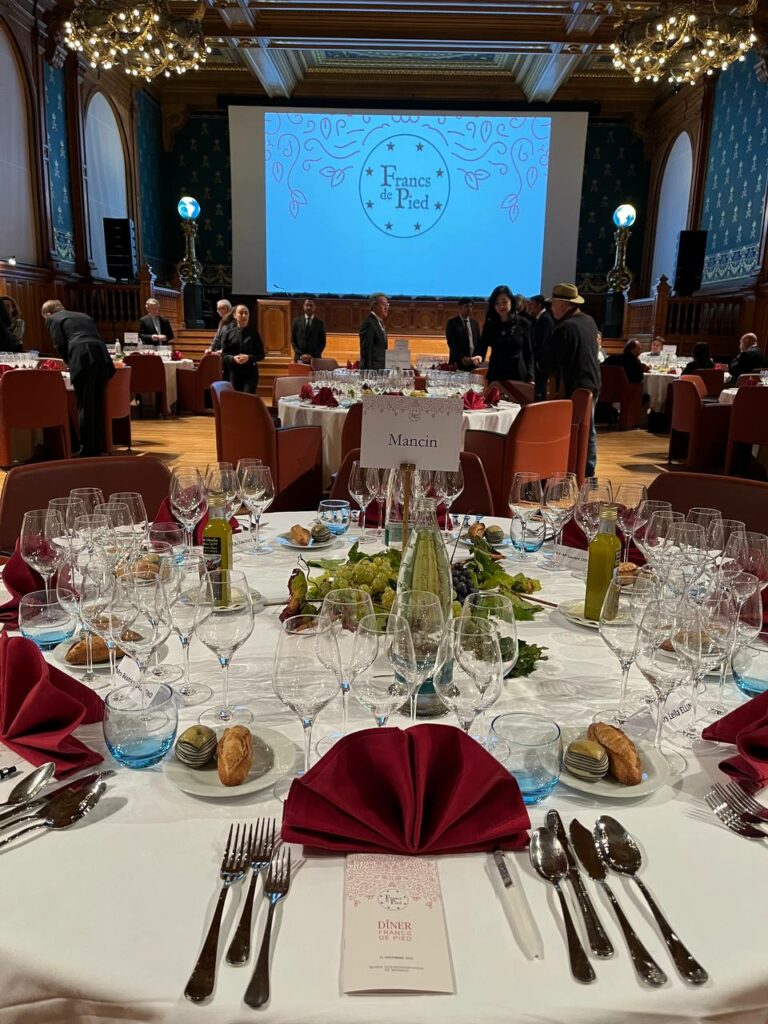
Les Francs de Pied: un Héritage
The association that strives to re-create the wine taste of the past
On 22 November 2022 in the Oceanographic Museum of Monaco a few hundred winemakers, journalists, and wine lovers gathered to celebrate the creation of the Association “Les Francs de Pied: un Héritage”.
Loïc Pasquet, the president of the new-born association and a winemaker of the famous Liber Pater, defined in his speech the primary objective – to unite all producers who have vineyards planted with native grape varieties in their place of origin. In this way, the Association wishes to protect and pass on centuries-old know-how, while respecting biodiversity by replanting the old vines in a balanced ecosystem. Saving these grape varieties means preserving the taste in its diversity and authenticity.
The Association “Les Francs de Pied : un Héritage” also aims to create and manage a label certifying the wines produced from ungrafted vines. This label will enable the supervision, traceability, and promotion of these unique wines that express the place of origin through their exceptional olfactory and gustative characteristics. The Association aims to register the know-how and traditions of vines “francs de pied” as part of UNESCO’s intangible cultural heritage.
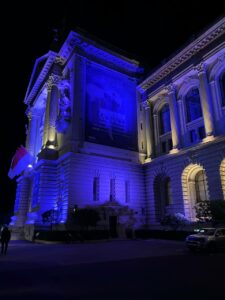 Robert Calcagno, the Director of the Oceanographic Museum in Monaco and the Secretary General of the Association, added that both establishments share one essential feature – the preservation of nature and the environment. He highlighted that ungrafted wines have been saved and restored by the will of a few winegrowers from several European countries who decided to plant their vines directly in the soil and not on a rootstock, a method that had become commonplace in all wineries after the great phylloxera crisis. This traditional technique, combined with respect for the soil and biodiversity, now gives wines of great finesse that express the full sensitivity of a terroir. H.S.H. Prince Albert II of Monaco, present at the dinner, supported the initiative and became one of the first ambassadors of the Association.
Robert Calcagno, the Director of the Oceanographic Museum in Monaco and the Secretary General of the Association, added that both establishments share one essential feature – the preservation of nature and the environment. He highlighted that ungrafted wines have been saved and restored by the will of a few winegrowers from several European countries who decided to plant their vines directly in the soil and not on a rootstock, a method that had become commonplace in all wineries after the great phylloxera crisis. This traditional technique, combined with respect for the soil and biodiversity, now gives wines of great finesse that express the full sensitivity of a terroir. H.S.H. Prince Albert II of Monaco, present at the dinner, supported the initiative and became one of the first ambassadors of the Association.
During the exclusive dinner prepared by chef Christian Garcia, the guests were able to enjoy and compare wines produced with grafted and ungrafted vines. These exceptional wines represented different parts of Europe and expressed perfectly the local terroirs. The association includes at the moment producers from France, Italy, Spain, Greece, Portugal, Germany, Switzerland, and Austria, among them – Egon Müller (Mosel, Germany), Thibault Liger-Belair (Bourgogne, France), Chartogne-Taillet (Champagne, France), Feudi di San Gregorio (Campania, Italy), Dominio de Es (Spain) and Filipa Pato (Portugal). Famous scientists like the ampelographer José Vouillamoz provide the theoretical base of the project.
 Nicolas Maillart – Les Coupés Ecueil 1er cru Francs de Pied Extra Brut 2018 – Champagne (France)
Nicolas Maillart – Les Coupés Ecueil 1er cru Francs de Pied Extra Brut 2018 – Champagne (France)
Made with 100% Pinot Noir, planted in 1973 on sandy soil, this wine is vinified and aged in used oak barrels. It shows a pale yellow straw colour with a copper hue. The nose is smoky and slightly oaky, offering nuances of red berries like strawberries and red currants, complicated by nuances of spices and caramel. The freshness and linearity on the palate balance perfectly the density, creaminess, and richness of the body. Notes of red fruits intertwine beautifully with nuances of chalk, sweet spices, and brioche. Very dry, lean, and cleansing finish. Perfect tension.
16.5/93
Contrada Contro – Vino di Sante 2020 – Marche (Italy)
This wine is produced with 120-year-old vines of local Malvasia Bianca di Candida, cultivated in a traditional way called “Maritata” when grape vines are “married” to maple trees and grow winding around the trunk and the branches of the “spouse”. Andrea Polidoro, the owner of the estate, found the ungrafted, pre-phylloxera wines, and decided to revive the ancient tradition of Monti Sibillini. The grapes are grown at a high altitude, around 500 metres above sea level, 50 km from the Adriatic sea. The wine is produced in a natural way in ceramic vessels. It shows a bright yellow straw colour with a golden tinge. The nose is perfumed and floral, revealing nuances of white flowers, apple blossom, and notes of citrus fruits and fresh grapes. The palate is lean and fresh, slightly diluted, offering nuances of fresh white pears and apples, a hint of lemon, and a delicate metallic touch. Very light in alcohol, this wine is easy-drinking and citrusy.
14.5/88
Thibault Liger-Belair – Domaine des Pierres Roses – Les Vignes Centenaires 2018 – Moulin à Vent (France)
This wine is a blend of three plots of Gamay planted before the phylloxera between 1870 and 1882. It is vinified with 50% whole bunches, partially aged in oak barrels for 18 months, and released in magnums only. The ungrafted parcels can resist water stress even in the hottest years and this wine shows outstanding freshness proving these characteristics. It has a deep, bright, and shiny ruby colour. The nose is slightly restrained in the beginning, later opening up with nuances of red and black cherries, a touch of sweet baking spices, and a hint of dark minerality. The palate is suave and fluid with velvety, juicy tannins and beautiful creamy but fresh acidity. The wine reveals nuances of cherry compote and baked raspberries, complicated by nuances of dried herbs and pungent spices, like nutmeg and grey pepper. The finish lingers long with a succulent red berries note.
17.5/95
Thibault Liger-Belair – Domaine des Pierres Roses – La Roche 2018 – Moulin à Vent (France)
The wine comes from a 2.25-ha plot situated at the top of Moulin à Vent hill. The vines are planted between 1920 and 1945, with a rootstock, on a soil composed of pink granite. The wine shows a bright and vivid ruby colour. The nose is exuberant and open, revealing nuances of red cherries and ripe strawberries, with a touch of underbrush and wet leaves in the echo. The palate offers crunchy, juicy acidity, suave texture and polished tannins, nice juiciness, and finesse. A bit herbal, with nuances of rose petals and hibiscus, a savoury touch of soya sauce, and strong black tea, this wine lingers long on the palate, leaving a juicy, slightly oaky, and peppery aftertaste.
16.5/93
 Dalamara – Vieilles Vignes 2019 – Naoussa (Greece)
Dalamara – Vieilles Vignes 2019 – Naoussa (Greece)
Located in the central part of Paliokalias single vineyard, a plot of 0.32ha ungrafted vines of Xinomavro dates back to the 19th century. They are survivors planted on their own roots. The soils are predominantly sandy laying on limestone bedrock. The wine has a pale, translucent ruby colour. On the nose, it offers perfumed nuances of dried rose petals, crunchy red cherries, and forest raspberries. The palate is smooth and velvety with delicate tannins, fresh acidity, and a lot of elegance and finesse. Its texture reminds an infusion of red tea, hibiscus flowers, and barberry.
16.5/93
Dalamara – Paliokalias 2019 – Naoussa (Greece)
Paliokalias is a single vineyard of Xinomavro bought by the Dalamaras family in the 1960s and later gradually extended. The wine shows an intense ruby colour, vivid and bright. The nose is floral and dense, offering nuances of dried rose petals and dried herbs like sage and oregano, complicated with notes of dark cherries and balsamic. The palate offers high concentration, elevated acidity, and bold, chalky tannins. Notes of flowers and cherries interlace with spicy nuances of black pepper and sweet spices. Dense and grippy finish. Good ageing potential.
16.5+/93-94
 Envinate – Táganan Tinto 2020 – Tenerife (Spain)
Envinate – Táganan Tinto 2020 – Tenerife (Spain)
The over 100-year-old vines are planted in Táganan, the northeast part of Tenerife, growing on the volcanic, basalt soil. The wine is a field blend of old local varieties, not all of them yet identified. Due to the rugged terrain, all the farming operations are executed by hand. During the harvest, animals are used to transport the grapes. The wine has a pale ruby colour with a purple tinge. The nose is smoky and reductive, the wine will benefit from being decanted. It offers nuances of sour red cherries, a touch of violets and peonies, some gunpowder, and flintiness. The body is light and aerial, complimented by elevated acidity and fluid, slightly rubbery tannins. The smoky notes linger on the palate, giving the wine its distinct character.
16/92
Egon Müller Scharzhofberger Kabinett 2015 – Mosel (Germany)
The wine shows a pale lemon colour, shiny and vivid. The nose is citrusy and floral, offering nuances of elderflower and white meadow flowers with notes of lemons and limes in the echo. The palate reveals zesty, extremely high acidity which balances perfectly the sweetness. Despite being light and lean, the wine shows extreme tension, linearity, and concentration. Eternal finish.
17.5/95
Egon Müller Scharzhofberger Alte Reben Kabinett 2015 – Mosel (Germany)
Made from a plot of old, ungrafted vines planted around 1900, this wine shows a pale, lemon green colour. The nose is delicate and floral, offering nuances of acacia and honeysuckle, a touch of lemon blossom and elderflower, complicated by a hint of wet stones and a fine smokiness. The palate is extremely fine and aerial and seems almost dry despite a serious load of sugar. It reveals subtle notes of lemon zest and lime pie, a hint of salinity, with some yellow apples and apricots in the background. Long, fresh, and cleansing finish. Amazing length.
18.5/97
Feudi di San Gregorio Serpico 2014 – Irpinia, Campania (Italy)
Serpico comes from “Dal Re”, a century-old, ungrafted vineyard of Aglianico. The wine shows a deep ruby colour with a garnet hue. It opens up with notes of black cherries and blackberries, a touch of black olives, and a hint of tar and incense. The palate is balanced and savoury with elevated, fresh acidity and polished, silky tannins, revealing nuances of bramble and cassis, complicated by nuances of graphite and dark minerality. Perfumed and complex, multi-layered wine with a juicy finish.
17.5/95
Feudi di San Gregorio Taurasi 2014 – Campania (Italy)
The wine shows a deep ruby colour with a garnet tinge. The nose opens up with savoury notes of dried tomatoes and black olives, a hint of roots and liquorice, and a touch of anise. The palate is round and poised with elevated, fresh acidity, suave and well-managed tannins, good freshness, and sapidity. The wine reveals a typical volcanic minerality with notes of smoke and iron, a touch of roasted meat, and juicy dark berries coating the palate. The finish lingers with a delicate ferrous note.
16/92
Liber Pater 2018 – Anticlinal Landiras, Graves (France)
A blend of Cabernet Sauvignon (Petite Vidure) and local varieties like Tarnay (Marcin), Castets, Saint-Macaire, Pardotte, and Rouge, found and revived by Loïc Pasquet, Liber Pater is an iconic wine. It shows a bright and vivid ruby colour. The nose is floral and perfumed, revealing nuances of sour red cherries, rose petals, and rosehip, with a touch of fresh tobacco and green pepper in the background. The palate is powerful with good fruit concentration, nice maturity of fruits but good freshness as well. The wine offers very polished, rounded tannins and a velvety, suave texture. Nuances of prunes and black cherries intertwine with notes of cigar tobacco and peonies. Long, fruity finish. The perfect purity of fruit.
17/94
Author: Valeria Tenison

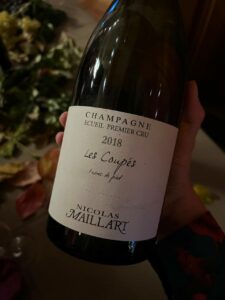 Nicolas Maillart – Les Coupés Ecueil 1er cru Francs de Pied Extra Brut 2018 – Champagne (France)
Nicolas Maillart – Les Coupés Ecueil 1er cru Francs de Pied Extra Brut 2018 – Champagne (France)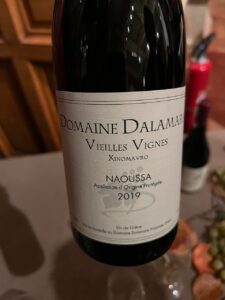 Dalamara – Vieilles Vignes 2019 – Naoussa (Greece)
Dalamara – Vieilles Vignes 2019 – Naoussa (Greece)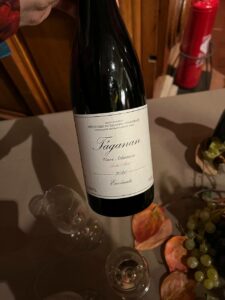 Envinate – Táganan Tinto 2020 – Tenerife (Spain)
Envinate – Táganan Tinto 2020 – Tenerife (Spain)